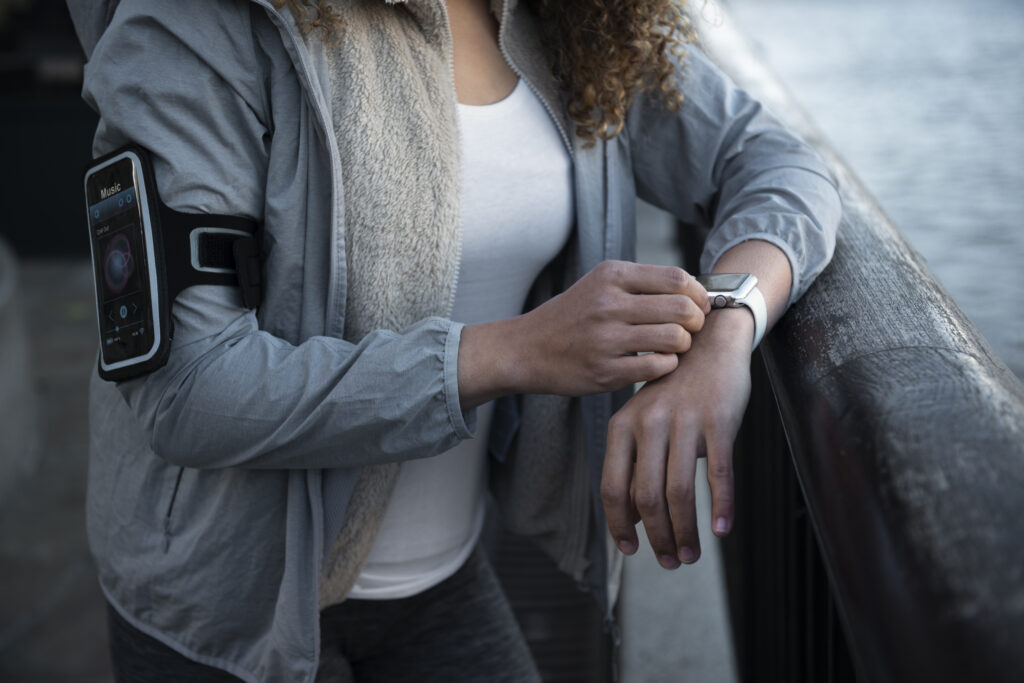Smart clothing is the meeting of old-world textiles and cutting-edge technology. These garments have the ability to continuously monitor things like heart rate, steps, and body temperature with embedded sensors.
Under the guidance of the New York based Fashion Tech Lab, companies from the United States develop and pilot these products for healthcare, sports and everyday applications. Hospitals and fitness organizations have implemented smart shirts and socks to allow patients and professional athletes alike to monitor their health.
The following pages discuss how these garments operate and what makes each unique.
What Exactly Is Smart Clothing?
Smart clothing refers to garments that utilize embedded technology to enhance their functionality beyond just basic protection of the body. These garments are equipped with sensors, small chips, or conductive fibers. They can track everything from your heart rate, temperature, all the way to your movements!
So they’re not just for athletes or tech enthusiasts! Healthcare teams keep a close watch on the health of their patients, and ordinary people to be more comfortable or track their steps. The technology embedded within the clothing connects with smartphones or computers.
It streams live biometric data and allows you to interact with other devices with a simple swipe or tap!
Defining the Connected Wardrobe
A connected wardrobe incorporates wearable technology into our everyday lives to create a more seamless experience. With smart shirts or smart socks, your clothing can connect to your smartphone or smart home just like your other devices.
Yes, a shirt can notify you when you’re overheating! It can remind you to get up and do a little stretching too. This information allows you to identify patterns in your health or gain insights that help you make informed decisions about physical activity and recovery.
A smart wardrobe would go a long way to reducing this waste! It tracks all your wear, tells you which pieces you wear the most, and encourages you to make smarter purchases.
Beyond Regular Threads: Key Differences
Smart fabrics offer more than just enhanced comfort. They can monitor your heart rate, they can wick away sweat, they can cool you down or warm you up and they can change their fit.
Smart textiles differ from everyday fabric in that they feature embedded conductive wires or sensors. This technology is what allows them to be so reactive to your body’s needs. Others are capable of real-time adaptation.
They shrink down for added compression, or shift hues to alert you of UV exposure!
The Core Tech Woven In
Key tech includes sensors, microchips, and wires that bend with the cloth. These allow the garments to track your health, relay information to your mobile device, and even record data.
Wireless technology makes it possible for all these devices and their sensors to communicate with each other without any plugs or cords. The ideal smart fabrics will find the sweet spot between all of these—enough strength, enough comfort, enough flexibility, so they can withstand washing and daily use.
How Smart Clothing Actually Works

Smart clothing combines advanced textile development with sensor technology. That’s primarily because it allows you to collect health and fitness data simply by using what you wear on a daily basis. Recent innovations in digital knitting and computer-aided design allow creators to knit sensors directly into the garments.
It looks at the sensors and power source, how it syncs with your phone, and how it reads all that data.
1. Tiny Sensors Doing Big Jobs
Today’s smart fabrics employ microscopic sensors—such as accelerometers, pressure sensors, and piezoresistive knits—to monitor heart rate, movement, and even levels of stress. These tiny sensors are incredibly powerful, catching even the slightest changes in pressure, temperature, and movement.
For instance, a piezoresistive knit will increase or decrease its resistance when you compress it. This feature allows it to monitor steps or recognize when you’re slouching. Advances since the 1990s have made these sensors significantly more accurate.
These new fibers are now capable of storing or conducting energy and even emitting light! It has made continuous health monitoring a reality, providing you with real-time insights that can help you better understand your body.
2. Connecting Fabric to Your Phone
Smart clothing transmits its data to your smartphone via Bluetooth or Wi-Fi. This allows for results to be seen in almost real-time. The accompanying mobile app takes those incoming health stats, interprets them, and simplifies them into easy-to-read, actionable insights.
Good app design matters here: a clear, user-focused interface helps users track fitness or health without confusion, boosting the value of smart clothing in healthcare and beyond.
3. Powering Your Wearable Tech
Wearable tech requires a ton of energy. Smart apparel can be powered with thin, lightweight batteries—or by technology that collects energy from sunlight and your movements. Some of them even incorporate fibers that store energy, which means self-powered clothing isn’t just a dream.
The trick is to incorporate those without adding any appreciable bulk to garments. Advancements in battery tech and energy-harvesting techniques mean longer use and less frequent recharging. On the other hand, sustainable alternatives truly work to reduce pollution.
4. How Data Gets Collected
Smart clothing collects data through its woven-in sensors, which send information to an onboard processor. The data’s accuracy is critical for health and fitness applications. Once the data is processed, it can be either kept locally on your device or sent to the cloud for more complex processing.
Cloud-based storage allows you to review your trends over time and helps clinicians monitor patients’ data long-term.
5. Making Sense of the Information
Finally, algorithms either in the mobile app or on the cloud analyze this raw data collected by your clothing. User-friendly dashboards display information in clear, understandable visual summaries, helping you quickly get a sense of your heart rate or stress levels.
Today, machine learning powers these apps to provide a deeper level of personal insight. It learns your behavior to become smarter over time and identify patterns that require your intervention.
Smart Clothing Uses We See Now
Smart clothing uses are definitely having a moment right now − in every industry here in the US. You’ve seen it in healthcare clinics, sports arenas, and industrial workplaces.
Today, consumers put on shirts with heart rate sensors built in, socks that count steps, and vests that detect body heat. These garments are instrumented with sensors and smart fabrics to collect real-time data. They allow users to make more informed decisions regarding their health and safety!
The trend is moving at breakneck speed, with innovative capabilities constantly emerging in our day-to-day apparel.
Monitoring Your Health Discreetly
For one thing, smart clothing is making it easier and more convenient than ever to track your health. Shirts and undergarments are fitted with woven sensors.
They can track your heart rate, oxygen levels, and even sleeping patterns without being obtrusive or cumbersome. This makes it easier for those with chronic health conditions to monitor their health.
In one case, diabetic patients were able to wear smart socks to identify foot injuries before they became problematic. Major companies have developed smart shirts to monitor breathing and heart conditions in the home or hospital.
The real benefit lies in receiving genuine, honest-to-goodness updates without the discomfort, clumsiness or crudity of cords or large displays.
Boosting Your Fitness Performance
Athletes and gym-goers wear smart clothing to receive actionable feedback on their performance in real-time as they exercise. These garments are able to calculate calories burned, levels of exercise intensity, and punch up posture.
Others vibrate at specific areas to cue improved form or alert the wearer to dangerous movement. Athletes wear shirts that display pulse and breathing to their mobile device, allowing them to train more effectively and efficiently.
Information gathered by these garments enables users to modify workouts and recover more quickly.
Enhancing Workplace Safety Gear
In environments such as manufacturing and building, smart vests and helmets today monitor for heat stroke or toxic fumes. Lightweight sensors trigger warnings when an individual approaches a hazardous area.
In the US, utility workers and miners wear smart clothing like these to reduce exposure to hazards. With real-time verification, assistance arrives in the nick of time.
Everyday Convenience Features
Smart textiles that could heat up on cold days and cool down in the heat are already being developed. Some of them allow users to tap to pay for things or sync with smartphones to message back and forth.
These convenience features would ease everyday life, accommodating unpredictable weather patterns or hectic schedules with ease.
When High Tech Meets High Fashion
The line between fashion and technology continues to blur as smart apparel expands. Currently, fashion brands and technology companies partner to release garments that do far more than look fab. Designers explore bold, new styles facilitated through intelligent textiles. They incorporate advanced textiles that monitor vitals, regulate body temp and sync to smartphones!
This trend is evident from streetwear to the luxury runways. Innovative designers are developing new products to satisfy consumers’ increasing desire for both fashionable and practical apparel.
Blending Style with Functionality
Today’s smart fashion blends style with authentic technological muscle. Some jackets heat you up using built-in heaters, others cool you down using special fibers. Maybe it’s shirts that can monitor your heart rate or suits that can provide subtle notifications.
Even with the additions, these pieces retain their crisp silhouette and geometric profiles, perfect for buyers seeking aesthetic beauty plus everyday functionality. Brands such as Levi’s and Ralph Lauren have already released connected denim jackets and fitness shirts.
These chic accessories are far from cumbersome tech paraphernalia. The challenge for other retailers is not just offering fashionable clothing but delivering obvious, user-friendly benefits.
Integrating Tech Seamlessly
In order for smart clothing to be effective, technology has to not be an impediment. Fashion designers invest many hours into concealing technology sensors and wires, ensuring that garments remain comfortable and luxurious.
In fact, some of these new fabrics even detect movement or stress without needing to incorporate any bulky hardware. AI tools are already being used in the design process, using customer preferences and designs to create new trends.
The real challenge is integrating these smart systems into garments that will hold up and be comfortable enough to wear everyday. We need to make sure that we don’t lose the aesthetic!
Is It Comfortable Though?
Comfort is key, as it always has been with smart clothing. The latest fabric technology incorporates lightweight, breathable materials that don’t leave wearers feeling burdened. Makers respond to feedback from wearers, iterating on the fit and feel with each new cycle.
Most smart clothing uses mesh or other natural fibers to reduce perspiration and improve ventilation. The design is what makes them perfect for long shifts and hot dog days.
This emphasis on comfort allows techwear to blend seamlessly into actual grind and daily life.
Hurdles Smart Clothing Faces
Smart clothing has introduced innovative methods to monitor health, enhance comfort, and integrate technology into everyday apparel. The path to practical deployment is fraught with hurdles. The industry still has major challenges that impede its broader adoption. These range from challenges around durability of garments and data security to cost, fit, and feel.
Making It Washable and Durable
Perhaps the biggest hurdle smart clothing faces is how to maintain the wearability of tech fabrics after repeat washes. It may sound simple, but sensors and wires can easily break down or cease function when exposed to water, detergent, or high temperatures. Other brands such as Levi’s, with their Jacquard jacket, have had success with tech that is washable.
Users are still concerned with the longevity of the features. It’s equally important that maintenance be easy—nobody wants textiles that require a special treatment. To combat this, various fabric blends and coatings have been experimented with in order to make these sensors both protective and pliable.
Yet, reliability may decrease, particularly when sweat or frequent washing becomes a factor in compromising accuracy.
Keeping Your Personal Data Safe
Smart clothing has the potential to collect a wide range of personal information, including everything from heart rate to walking gait. This raises issues of privacy and hacking. Without proper security measures, data breaches for wearables could provide access to sensitive health information.
To foster faith in smart clothing, manufacturers will need to implement vigorous encryption protocols along with well-defined privacy policies. Since consumers are likely concerned about where their data will be stored and shared, transparency on data practices is critical.
The Current Cost Factor
Smart clothing is much more expensive than normal clothing. High-tech fabrics, sensors, and batteries all contribute to the cost. For most, these expenses far exceed the value of the benefits provided.
While prices can be expected to decrease as production scales up, that will not happen overnight. Perhaps bulk manufacturing and more durable materials will afford that, but it’s a big question mark.
Getting the Fit and Feel Right
Fit and comfort are the number one reasons consumers choose smart clothing. According to survey data, comfort is the most important factor for nearly 80% of buyers. Clothing tech needs to be intuitive to wear and conform to different body shapes.
While custom sizing and softer materials may be a part of the solution, finding the right balance between style, function, and tech will prove challenging. Brands are currently working on prototypes with smart fabrics that stretch and move as needed.
Getting the fit and feel right is still a bit of an art.
What’s Next for Tech Clothing?
With all this momentum in the US and abroad, tech clothing is being pushed quickly by new concepts and actual user needs. Now, researchers and brands are trying to create clothes that serve a purpose beyond simply being fashionable. They provide additional benefits beyond the tech itself, such as comfort, health tracking and integrating technology seamlessly into everyday life.
All this demand from professional healthcare and personal active lifestyles is moving the next generation, more technologically advanced and connected fabrics into the mainstream.
Innovations in Smart Fabrics
Today’s most advanced smart fabrics offer an array of abilities beyond simply sensing a touch or monitoring heart rate. Other innovative materials are able to react to changes in temperature, UV light or motion. They intelligently adapt their appearance or texture in response to the ambient atmosphere.
For instance, laboratories are creating garments that measure hydration or anxiety through interpreting skin responses. Flexible electronics and soft sensors are today literally knitted directly into t-shirts and stockings. This allows them to sense vital signs without heavy devices.
Further developments are aimed at ensuring these textiles remain washable, durable, and with a comfortable feel over extended use. On top of that, some teams are creating their products with recycled fibers, doing good for the Earth.
Better Batteries, Smaller Tech
Battery life has long been the major sticking point. Today, new, smaller, lighter power sources are being introduced. These improvements allow smart shirts or smart patches to operate for longer periods of time between charges.
As businesses continue to shrink sensors and chips, it could all be made to fit in a sleeve or collar without a hassle. New battery tech, like flexible lithium cells or energy harvesting from motion, could soon let wearables charge as you move.
This can help present smart clothing as less of a hassle and more integrated into everyday wardrobe.
Potential Future Applications
Smart clothing promises to benefit much larger segments than athletes or tech enthusiasts. Connected gowns Hospitals could also use connected gowns to monitor patients’ vitals. Home health is another area where tech shirts that can monitor breathing or send alerts in case of a fall could help.
Brain-computer interfaces could potentially enable users with reduced mobility to use their thoughts to operate devices. Regular consumers might experience garments that change based on climate, display augmented reality notifications, or connect to smart home devices.
The direction is definitely towards gorgeously seamless integrations of fashion, function, & health.
My Thoughts: Gimmick or Game Changer?
Smart clothing occupies a precarious position. Others deride it as a gimmick—something that’s really neat, but addresses absolutely no need. Still others believe it is the next evolution of wearables. As a longtime technical analyst working in San Francisco, I can understand both sides.
The concept of tech-in-clothing is by no means a new one. Wearable technology held the same promise of revolution, but many of those early wearables just found themselves in a drawer never to be seen again. Nonetheless, the potential of smart apparel is genuine—if it is developed appropriately.
Where I See Real Value
There are a lot of positive benefits that smart clothing can provide to everyday life if it’s done correctly. Take for instance a bionic bra, which would be outfitted with sensors to actively adapt its fit as your body shifts. That’s not just a gimmick, as we’ll see.
It translates to greater ease for more hours. Health monitoring is a third key benefit. Shirts that monitor heart rate or measure breathing patterns will allow people to detect issues sooner and more easily. For performers, smart fabrics can monitor perspiration or physical stress.
With this data, they can train much safer and smarter. If designers can find ways to make these items blend in, that’s a win! Folks will be able to wear them comfortably, whether at work or the gym. Clothes you can wear multiple ways—dressed up or down—are better value.
What Still Needs Improvement
There are major obstacles. A big reason that many applications of smart clothing haven’t taken off is that they just aren’t rugged enough. Wires have the potential to snap. RFID sensors can be rendered useless after laundry cycles.
Comfort is not just a secondary consideration here. If tech components are uncomfortable or intrusive, folks won’t use them. Data privacy is an equally troubling issue. This is particularly true for health data, which requires the highest level of protection.
Cost is a huge barrier right now. Not only are most smart clothes expensive, pricing many smart clothes out of the average consumer’s budget.
Will We All Wear Smart Clothes?
Smart clothing has a better chance of making headlines if it’s seamlessly integrated into everyday activities. People don’t like being tracked; they prefer to be comfortable and prices should be reasonable.
Trends certainly have some influence, but for any change to be lasting and substantive, smart clothes will need to address some legitimate issues. If brands are able to accomplish that, more consumers are on board.
If products come off as gimmicks, however, widespread acceptance will be hampered.
Conclusion
Smart clothing moves beyond the hype. It monitors health, records workouts, and keeps people fit in the office or the fitness center. In hospitals, physicians use the smart shirts to detect cardiac issues quickly. Smart socks runners can put on socks that monitor their running form. These aren’t just flashy gadgets—they’re making a tangible difference. Okay, a few potholes delay development. Wash cycles kill sensors, and costs are still high and scary. The point is that makers continue to solve issues and release new devices every 12 months. Smart fabric might soon be as ubiquitous as blue jeans. Anyone across health tech, fashion, or sports needs to be watching these trends. Consider the ways this type of gear could support you personally or professionally. Get in there, experiment with some equipment, and figure out what works.






